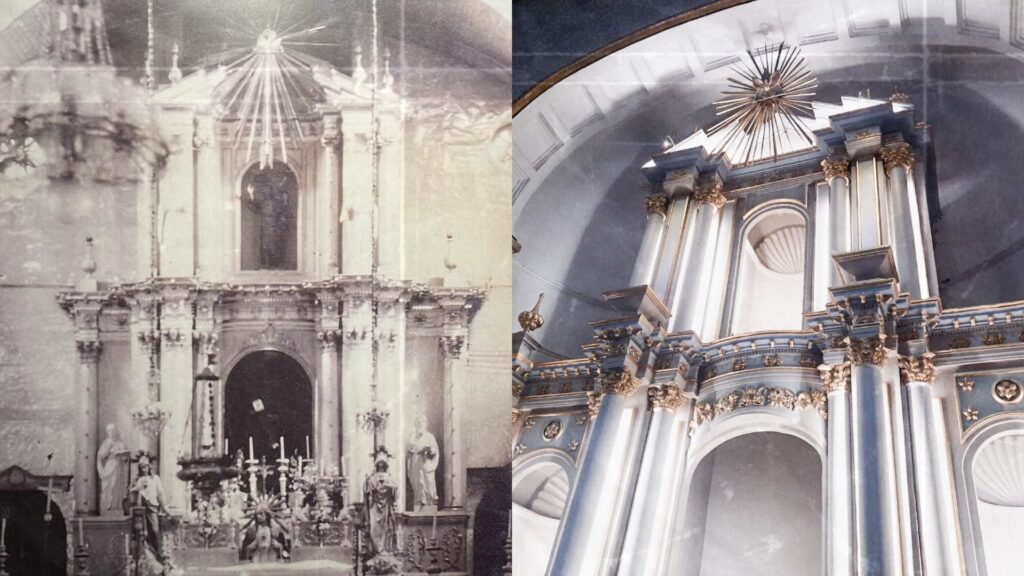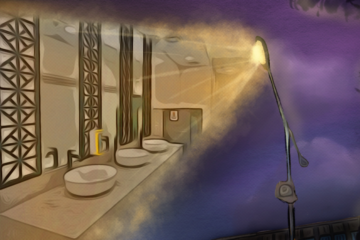
THE QUIAPO Church has built a replica of its pre-World War II retablo that housed the centuries-old image of Jesus Nazareno, a religious icon honored by millions of devotees annually on Jan. 9.
The retablo, a multi-layered structure functioning as a frame or shelf for saints and religious paintings, details gold floral embellishments on top of carrara marbled vertical columns with seashell carvings inside. A golden starburst ornament with a sculpted bird and a triangle also stands atop the altar piece.
The original version of the retablo, usually positioned behind an altar, was designed based on a combination of neoclassical and baroque architecture and built under Spanish rule, according to Quiapo Church Social Communications Ministry Coordinator Benedict Canapi.
He said the recreation of the old retablo, which was spearheaded by architect Roy De Guzman, symbolized the “richness of one’s culture.”
“He (De Guzman) was able to acquire old pictures from the Intramuros administration [that allowed us] to rebuild or reconstruct—not on a full scale, but on a smaller scale—the old retablo of Quiapo,” Canapi told The Flame.
The retablo is located near the entrance of the church and beside the image of Our Lady of Peace and Good Voyage.
Also known as the Minor Basilica and National Shrine of Jesus Nazareno, Quiapo Church was established in 1588 under the patronage of St. John the Baptist, cousin of Jesus Christ and the one who announced His coming.
The saint’s image was formerly positioned on top of the retablo of the altar during the Spanish colonial period before the arrival of Jesus Nazareno, whose image was believed to have been brought by Augustinian Recollect missionaries from Mexico to the Philippines in 1606.
The entire Quiapo Church was burned along with the retablo in 1929 except for the Nazarene, a dark wooden statue of Jesus Christ carrying a large black wooden cross. The image was the only pre-war object saved after the disaster.
National Artist Architect Juan Nakpil redesigned the church after several demolitions, incorporating the old Baroque style of concrete instead of stone. The reconstruction was finished in 1935.
World War II erupted four years after the rebuilding of the Quiapo Church, leaving Manila with 11,000 destroyed buildings and 100,000 dead civilians. However, the church was able to withstand the conflict.
“One of the miracles that we believe [happened to the church] was World War II. We do not know why the Quiapo and San Sebastian [churches] survived knowing that the Santa Cruz Church was near us, which was the primary (target) of the bomb,” Canapi said.
As of writing, the Quiapo Church’s retablo has yet to display religious images, but it has been a tradition to put an image of Jesus Nazareno at its center in honor of its historical significance to the shrine.
According to scholars, the cross-carrying Jesus Nazareno resonates deeply with Filipinos as he embodies the struggle with hardship and adversity. Some devotees also believe that the image possesses miraculous powers of healing and protection.
Millions of devotees commemorate the image of Jesus Christ through Traslacion, a whole-day procession wherein the statue is pulled by two ropes carried by barefoot from Quirino Grandstand to the shrine. Devotees go barefoot during the procession as an act of penance and to emulate Jesus’ humility and sacrifice. Some also bring handkerchiefs and towels to touch the image.
This year, the Manila local government unit will deploy 14,000 police and military personnel and medical teams to aid in the procession. Road closures and a ban on guns and liquor will also be implemented starting Jan. 8.
The Traslacion commemorates the solemn transfer of the Jesus Nazareno from Intramuros to Quiapo in 1787. F — with reports from Francia Migyel Violeta



